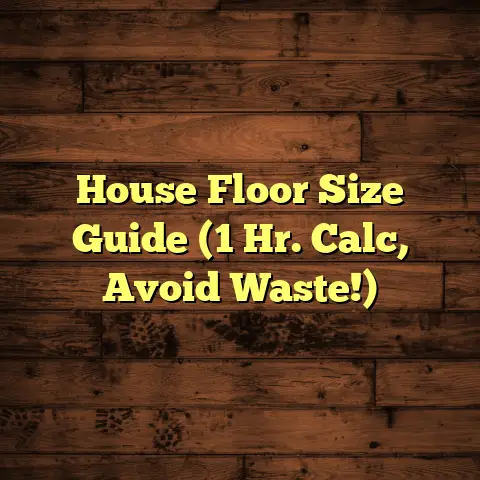Laminate Floor Clicking? (1 Quick Solution!)
I’ve seen it all, from hairline cracks in the foundation to rogue squirrels nesting under floorboards (true story!).
But one thing that always seems to send homeowners into a panic is that click, click, click coming from their laminate floors.
The first thing many people think is, “Oh no, my floor is ruined!
Time to rip it all out!”
Hold on a second!
Before you start pricing out new flooring, let’s get one thing straight: not all laminate floor clicking means disaster.
Trust me, I’ve seen plenty of cases where a simple fix can silence those pesky noises.
So, let’s get to the bottom of this and see if we can save you some serious time and money.
Section 1: Understanding Laminate Flooring
Okay, so what exactly is laminate flooring?
I mean, we walk on it every day, but do we really know what’s under our feet?
1. Define Laminate Flooring
Laminate flooring is basically a multi-layered synthetic flooring product fused together through a lamination process.
Think of it like a high-tech sandwich for your floor.
Typically, it consists of four layers:
Wear Layer: This is the top, transparent layer that protects the floor from scratches, stains, and fading.
It’s usually made of aluminum oxide.Decorative Layer: This is where the magic happens!
It’s a high-resolution photographic image that gives the laminate its wood, stone, or tile look.Core Board: This is the heart of the laminate.
It’s usually made of high-density fiberboard (HDF) or medium-density fiberboard (MDF).
This layer provides stability and resistance to impacts.-
Backing Layer: This bottom layer provides a moisture barrier and helps to balance the floor, preventing warping.
Why is Laminate Flooring So Popular?
Well, for starters, it’s affordable.
Compared to hardwood or tile, laminate is a budget-friendly option.
Plus, it’s easy to install.
Most laminate floors come with a click-lock system, which means you can often install them yourself without needing a professional (though I’m always happy to help!).
And let’s not forget the aesthetic appeal.
With advancements in printing technology, laminate can mimic the look of real wood or stone incredibly well.
2. Common Issues with Laminate Flooring
While laminate is a great option, it’s not without its problems.
I’ve seen it all:
-
Warping: This happens when moisture gets into the core board, causing it to swell and distort.
-
Buckling: Similar to warping, buckling occurs when the floor expands and has nowhere to go, causing it to lift off the subfloor.
Clicking Noises: Ah, yes, the reason we’re all here!
These annoying sounds can be caused by a variety of factors, which we’ll dive into next.
Section 2: The Science Behind Laminate Floor Clicking
Alright, let’s put on our detective hats and figure out why your laminate floor is making those noises.
1. What Causes Clicking Noises?
Think about it: your floor is under constant pressure from furniture, foot traffic, and temperature changes.
All these factors can contribute to those clicks and pops.
Here’s a breakdown:
Expansion and Contraction: Laminate flooring expands and contracts with changes in temperature and humidity.
If the floor is installed too tightly against the walls, it won’t have room to move, and that pressure can cause clicking.Improper Installation: This is a big one.
If the subfloor isn’t level or if the planks aren’t properly locked together, you’re almost guaranteed to hear some noises.-
Subfloor Imperfections: Even if the subfloor looks level, there might be small bumps or dips that can cause the laminate to flex and click when you walk on it.
-
Debris: Sometimes, a small piece of debris, like a pebble or a nail, can get trapped under the floor and cause clicking.
I once had a client who swore their floor was haunted because of the clicking.
Turns out, it was just a rogue Lego brick stuck underneath!
2. Different Types of Clicking Sounds
Not all clicks are created equal.
Here’s how to distinguish between harmless sounds and potential problems:
Popping: This is often caused by expansion and contraction.
It’s usually more noticeable during seasonal changes.-
Creaking: This can indicate that the subfloor is uneven or that the planks aren’t properly locked together.
-
Sharp, Distinct Clicks: This might be a sign of debris under the floor or a loose plank.
-
Consistent Clicking in One Area: This usually points to a specific problem spot, like an uneven subfloor or a loose plank.
Table 1: Troubleshooting Laminate Floor Sounds
Section 3: The Quick Solution to Laminate Floor Clicking
Okay, enough with the theory! Let’s get to the fix.
1. Identify the Source of the Clicking
Before you can fix the problem, you need to find out where it’s coming from.
Here’s how:
Walk Around: Slowly walk around the room, paying attention to where you hear the clicking.
Try to pinpoint the exact location.Apply Pressure: Once you’ve identified a general area, apply pressure to different spots on the floor.
Does the clicking get louder or softer?-
Check the Perimeter: Walk along the edges of the room and see if the clicking is more pronounced near the walls.
Inspect Planks: Look closely at the planks in the affected area.
Are any of them loose or damaged?
2. The One Quick Solution: Felt Pads to the Rescue!
In many cases, the clicking is caused by furniture legs rubbing against the laminate floor.
The solution?
Felt pads!
These little adhesive pads are a lifesaver.
Just stick them to the bottom of your furniture legs, and they’ll create a smooth barrier between the furniture and the floor.
How to Implement This Solution:
-
Clean the Furniture Legs: Make sure the bottom of the furniture legs are clean and dry.
-
Peel and Stick: Peel the backing off the felt pad and stick it firmly to the bottom of the leg.
-
Test It Out: Move the furniture around and see if the clicking is gone.
I know, it sounds too simple to be true, but trust me, this works more often than you’d think.
3. Case Study: The Case of the Clicking Coffee Table
I had a client, Sarah, who was ready to tear up her entire living room floor because of a persistent clicking sound.
After a bit of detective work, we realized the clicking was coming from her coffee table.
The legs were slightly uneven, and every time someone set a drink down or bumped the table, it would click against the floor.
A few felt pads later, and the clicking was gone!
Sarah was so relieved she didn’t have to spend thousands on a new floor.
Section 4: Long-Term Maintenance Tips for Laminate Flooring
Alright, you’ve silenced the clicks (hopefully!).
Now, let’s talk about how to keep your laminate floor happy and quiet for years to come.
1. Regular Maintenance Practices
Sweep or Vacuum Regularly: This will prevent dirt and debris from scratching the floor.
Use a soft-bristled broom or a vacuum with a floor brush attachment.-
Mop with a Damp Cloth: Use a laminate-specific cleaner and a damp (not soaking wet!) cloth to mop the floor.
Control Humidity: Laminate flooring is sensitive to moisture.
Use a humidifier or dehumidifier to keep the humidity level between 30% and 50%.-
Use Rugs in High-Traffic Areas: This will protect the floor from wear and tear.
-
Inspect Regularly: Keep an eye out for any signs of damage, like scratches, dents, or warping.
Table 2: Laminate Flooring Maintenance Schedule
2. When to Seek Professional Help
Okay, so you’ve tried the felt pads, you’re keeping the floor clean, and you’re still hearing those clicks.
When is it time to call in the pros?
-
If the Clicking is Widespread: If the clicking is happening all over the floor, it’s likely a subfloor issue or an installation problem that’s beyond a simple DIY fix.
-
If You See Visible Damage: If you notice warping, buckling, or damaged planks, it’s best to consult a professional.
If You’re Not Comfortable Doing It Yourself: Let’s be honest, some flooring repairs can be tricky.
If you’re not confident in your DIY skills, it’s always better to call a professional.
Conclusion
So, there you have it!
Laminate floor clicking can be annoying, but it’s often a fixable problem.
Remember that quick solution – felt pads – and keep up with regular maintenance to prevent future issues.
And if all else fails, don’t hesitate to call a professional.
We’re here to help!
Remember, a little bit of knowledge and a few simple steps can go a long way in keeping your laminate floors looking and sounding their best.
Happy flooring!





